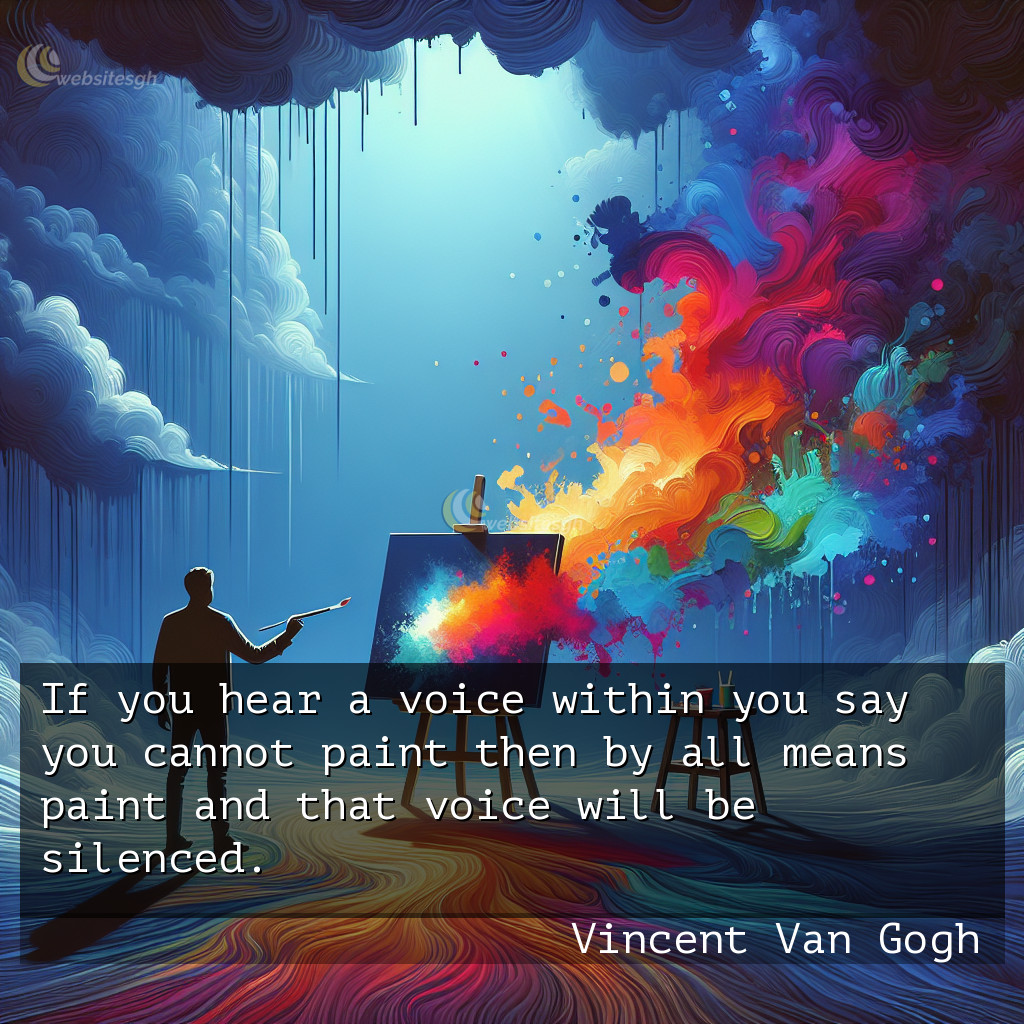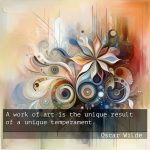This website uses cookies so that we can provide you with the best user experience possible. Cookie information is stored in your browser and performs functions such as recognising you when you return to our website and helping our team to understand which sections of the website you find most interesting and useful.

Vincent Van Gogh Quotes on Art

Vincent Van Gogh Quotes on Art SAq4
If you hear a voice within you say you cannot paint then by all means paint and that voice will be silenced.
By: Vincent Van Gogh
Overcoming the Inner Critic
We all have an inner voice that whispers, sometimes screams, doubts and fears into our minds. It tells us we’re not good enough, that we can’t achieve our dreams, or that we’re bound to fail. This voice can be paralyzing, preventing us from pursuing our passions and living our lives to the fullest. But what if we could silence that voice? What if we could prove it wrong?
Vincent Van Gogh, one of the most renowned artists in history, once said, “If you hear a voice within you say you cannot paint, then by all means paint and that voice will be silenced.” This powerful statement is not just about painting; it’s about facing any challenge head-on, regardless of the doubts that may plague us.
Embracing the Challenge
When we decide to take action despite our fears, we embark on a journey of self-improvement and resilience. The act of doing, of engaging with our passions, is a direct confrontation with the inner critic that tells us we’re incapable. By painting, writing, singing, or simply moving forward with our goals, we’re sending a clear message to ourselves: we are stronger than our doubts.
Building Confidence Through Action
Every stroke of the brush, every word on the page, and every note in the air is a step towards silencing the negative voice within. With each action, we build a little more confidence, a little more evidence that we can do what we set our minds to. It’s not about being perfect or creating a masterpiece every time; it’s about the process of growth and the satisfaction of trying.
Learning from Failure
Failure is an inevitable part of life, but it’s also a powerful teacher. When we fail, we learn what doesn’t work, which brings us closer to discovering what does. The voice that tells us we can’t do something often fears failure, but by embracing it as a learning opportunity, we can turn that fear into a tool for improvement.
Surrounding Ourselves with Support
The journey to silencing our inner critic is not one we have to take alone. Surrounding ourselves with supportive friends, family, and mentors can make all the difference. These are the people who will encourage us when we’re down, celebrate our successes, and remind us of our worth when we forget.
Setting Realistic Goals
It’s important to set goals that challenge us but are also achievable. Unrealistic expectations can feed the inner critic and set us up for disappointment. By setting smaller, realistic goals, we can build momentum and create a positive feedback loop that quiets the negative voice within.
Practicing Self-Compassion
We must be kind to ourselves. Self-compassion is recognizing that we’re human, we make mistakes, and that’s okay. When we treat ourselves with the same kindness we would offer a friend, we create a nurturing environment for growth and silence the inner critic that thrives on self-judgment.
Staying Persistent
Persistence is key. The voice within that says we can’t do something is persistent, so we must be even more so. Every day that we choose to engage with our passions, despite the doubts, is a victory. Over time, the voice gets quieter, and our confidence grows louder.
Reflecting on Progress
Taking the time to reflect on how far we’ve come can be incredibly motivating. It’s easy to forget the progress we’ve made when we’re focused on the road ahead. By looking back, we can see the multitude of silenced doubts behind us and gain the strength to face the ones ahead.
Embracing the Journey
Finally, it’s about embracing the journey. The path to silencing our inner critic is not a straight line; it’s filled with ups and downs. But each step is a part of a larger, beautiful journey of self-discovery and empowerment. By choosing to paint, to create, to act, we’re not just silencing a voice; we’re finding our own.
FAQs about Vincent Van Gogh on Art
- What did Vincent Van Gogh mean by saying you should paint to silence the voice that says you cannot?
Van Gogh was encouraging individuals to defy their self-doubt. By taking action and painting (or doing whatever you’re hesitant about), you confront your fears and prove to yourself that you can overcome them, which in turn silences the negative inner voice.
- How can Van Gogh’s advice apply to activities other than painting?
Van Gogh’s advice is metaphorical and can apply to any area of life where self-doubt creeps in. Whether it’s writing, learning an instrument, starting a business, or any personal goal, the principle of taking action to overcome self-doubt is universal.
- Why is it important to set realistic goals?
Setting realistic goals is crucial because it helps maintain motivation and prevents the feeling of being overwhelmed. Achievable goals provide a sense of accomplishment and build confidence, which can help silence the inner critic.
- Can failure really help silence the inner critic?
Yes, failure can be a powerful tool in silencing the inner critic because it provides valuable lessons. Learning from failure can improve future attempts and build resilience, which weakens the power of self-doubt.
- How can friends and family help in overcoming self-doubt?
Friends and family can offer encouragement, provide a different perspective, and remind you of your abilities when self-doubt arises. Their support can be a strong counter to the negative voice within.
- Why is self-compassion important in silencing the inner critic?
Self-compassion involves treating yourself with kindness and understanding, which is the opposite of what the inner critic does. By being compassionate towards ourselves, we create a positive mindset that can counteract and eventually silence the inner critic.
- How does persistence help in overcoming the voice that says you can’t do something?
Persistence shows the inner critic that you won’t be deterred by setbacks or negative thoughts. It’s about continuing to move forward and take action, which eventually leads to improvement and success, quieting the doubts.
- What is the significance of reflecting on progress?
Reflecting on progress helps to recognize and celebrate achievements, no matter how small. This can boost morale and provide concrete evidence against the inner critic’s claims that you can’t do something.
- Is it possible to completely silence the inner critic?
While it may not be possible to completely silence the inner critic forever, it is possible to greatly reduce its influence. Through consistent action, learning, and self-compassion, the inner critic’s voice can become a faint whisper instead of a dominating force.
- Did Vincent Van Gogh ever struggle with self-doubt?
Yes, Van Gogh struggled with self-doubt and mental health issues throughout his life. Despite this, he created some of the most celebrated works of art in history, which serves as a testament to the power of perseverance and the human spirit.









